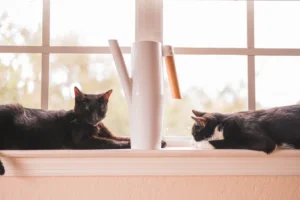Cats have long been perceived as dominant creatures, often asserting themselves in various situations with confidence and authority. But why exactly are cats dominant? Let’s explore the reasons behind their natural sense of superiority.
Evolutionary History
Cats’ dominant behavior can be traced back to their evolutionary history as skilled hunters and solitary predators. Their ancestors, such as the African wildcat, relied on their hunting instincts to survive in the wild. Over time, these survival skills have been passed down through generations, leading to the development of a strong prey drive and territorial behavior in modern domestic cats.
The instinct to be dominant is deeply ingrained in cats as a means of survival. In the wild, dominant cats would have access to the best food sources and territories, increasing their chances of survival. This drive for dominance has been carried over to domestic cats, who often display dominant behavior in their interactions with other animals and humans.
Furthermore, cats have retained their solitary nature from their ancestors, which can contribute to their dominant behavior. Unlike pack animals that rely on social hierarchy for survival, cats are more independent and prefer to establish their dominance through assertive behaviors.
In essence, cats’ dominance stems from their evolutionary traits as hunters and solitary predators. Understanding this background can help owners better navigate their cats’ behavior and provide an environment that meets their natural instincts.
Social Hierarchy
In the feline world, social hierarchy plays a crucial role in how cats interact with one another. Establishing dominance within this hierarchy is essential for cats to define their place in their social group and maintain order within the group.
When living in multi-cat households or interacting with other animals, cats rely on dominance to establish boundaries, assert their authority, and claim resources such as food, territory, and attention. This behavior is a natural way for cats to communicate and maintain balance within their social structure.
To maintain a harmonious environment in a multi-cat household, it’s important for owners to understand and respect their cats’ need for dominance. Providing each cat with their own resources, such as food, water, and litter boxes, can help reduce competition and conflict among cats.
In essence, a cat’s need for dominance is rooted in their social hierarchy and the natural order of their social structure. By recognizing and respecting this aspect of their behavior, owners can create a peaceful and balanced environment for their feline companions.
Additional Unique Insight: Cats often use body language, such as tail position and ear movement, to establish dominance within their social hierarchy. Observing these subtle cues can provide valuable insights into how cats interact and communicate with one another.
Territorial Instincts
Cats are known for their dominant behavior, especially when it comes to defending their territory. Territorial Instincts are deeply ingrained in cats’ nature, stemming from their ancestors who needed to protect their food and shelter. This instinct can manifest in dominant behavior towards other animals and even humans who pose a perceived threat to their space. When a cat displays dominance, it’s their way of asserting control over their environment and ensuring their safety.
One unique insight into cats’ territorial instincts is that they have a keen sense of smell, which plays a crucial role in marking their territory. Cats use scent glands located on their face, paws, and tail to leave pheromones on objects in their environment. This scent marking is a way for cats to establish ownership of a particular area and communicate their presence to other animals. Understanding this behavior can help pet owners create a harmonious living space for their feline companions.
Communication Through Dominance
Cats communicate through various behaviors, and dominance is one of the ways they convey their needs and assert their boundaries. Communication Through Dominance is not necessarily aggressive but rather a way for cats to establish hierarchy and maintain order within their social structure. When a cat displays dominant behavior, such as puffing up their fur or making direct eye contact, they are sending a clear message to others about their position.
One important aspect of cats’ communication through dominance is their body language. By observing a cat’s posture, tail movement, and vocalizations, pet owners can better understand their feline companion’s needs and emotions. It’s essential to respect a cat’s boundaries and not challenge their dominance, as this can lead to stress and tension in the relationship. By learning to interpret their signals, you can strengthen the bond with your cat and create a more harmonious environment for both of you.
Instinctual Behaviors
Cats’ dominant tendencies stem from their instinctual behaviors. Marking territory is a common behavior where cats spray urine to assert ownership over their space. By establishing boundaries, cats communicate dominance to other animals, ensuring they understand who’s in charge. Furthermore, asserting control over resources like food, water, and toys is a way for cats to showcase their dominance. In the wild, securing access to vital resources ensures survival, a trait still evident in domestic cats. Lastly, establishing their role within a social group is crucial for cats’ survival instincts. Whether living with other cats or humans, cats have a hierarchy within the group, with dominant cats being more assertive in interactions. Understanding these instinctual behaviors can help pet owners better navigate their cats’ dominant tendencies.
Training and Socialization
Early training and socialization play a key role in shaping a cat’s behavior and curbing dominant tendencies. By providing consistent positive reinforcement for good behavior, such as using treats or praise, cats learn what is acceptable behavior in the household. Setting boundaries is also crucial in teaching cats limits and preventing them from becoming overly dominant. For example, not allowing cats to scratch furniture or jump on countertops helps establish rules they must follow. When cats are socialized from a young age, they learn to interact with other animals and humans in a positive way, reducing the likelihood of aggressive or dominant behavior. By incorporating training techniques and promoting positive social interactions early on, pet owners can help mold their cats into well-behaved and less dominant companions.
Additional Unique Insight: Introducing new experiences and environments to cats at a young age can help reduce dominant behaviors. Exposing cats to different stimuli, such as car rides, new people, and unfamiliar smells, can increase their adaptability and confidence, leading to less dominance in the long run.
Handling Dominance in Multicat Homes
If you’re living in a multicat household and noticing one of your feline friends displaying dominant behavior, there are a few strategies you can implement to promote harmony among your furry companions. First and foremost, provide plenty of vertical space with cat trees and shelves to allow each cat to establish their territory. Separate resources such as food bowls, litter boxes, and resting areas can help prevent conflicts over limited essentials. Interactive playtime with each cat individually can also help release any pent-up energy and reduce the need for dominance displays. Additionally, regular veterinary check-ups can rule out any underlying health issues that might be contributing to dominant behavior.
Health and Dominance
While cat dominance can be influenced by various factors such as genetics and socialization, it’s crucial to consider potential health issues that could be exacerbating dominant behavior. Cats may resort to dominance as a way to mask discomfort or pain. Regular visits to the vet can help identify and address any underlying health problems, which may alleviate the need for dominant displays. Common ailments like arthritis, dental issues, or urinary tract infections can manifest as dominance, so monitoring your cat’s health is essential to promote overall well-being and reduce aggressive behavior.
Tips for Handling Dominance in Multicat Homes:
- Provide vertical space: Cat trees and shelves help establish territories.
- Separate resources: Food, litter boxes, and resting areas should be allocated for each cat.
- Interactive playtime: Engage each cat individually to release energy and reduce tension.
- Regular vet check-ups: Addressing health issues can alleviate dominant behavior.
- Monitor for signs of discomfort: Aggression might be a symptom of an underlying health problem.
Interesting Fact: Lion vs. House Cat
Did you know that despite their size difference, lions and house cats share some intriguing similarities in their dominant behavior? In the wild, lions exhibit a clear hierarchical structure within their pride, with dominant individuals leading the group and asserting their authority. This dominance is crucial for maintaining order, securing resources, and ensuring survival in their natural habitat.
On the other hand, house cats, while smaller in size, also display dominant behaviors within multi-cat households. They may engage in subtle power struggles, such as claiming territories or resources, to establish their position within the social hierarchy. Interestingly, house cats may form alliances or engage in cooperative behaviors with other cats to navigate these complex social dynamics.
While the dominance dynamics between lions and house cats differ due to their environments and social structures, both species showcase intriguing parallels in how they assert dominance to maintain social order and secure their place within the group.
Mythbusting: The “Alpha” Cat
Contrary to popular belief, the concept of an “alpha” cat in a household is not as straightforward as it seems. Cats do not strictly adhere to a simplistic alpha-beta hierarchy like some other animal species. Instead, feline social dynamics are multifaceted, with relationships influenced by factors such as individual personalities, resource availability, and past experiences.
While some cats may exhibit more assertive or dominant behaviors, labeling one cat as the “alpha” can oversimplify the complexities of their interactions. Cats may engage in subtle forms of communication, such as body language, vocalizations, and scent marking, to negotiate their social standing within the group.
Understanding and respecting each cat’s unique personality and preferences, providing adequate resources and enrichment, and promoting harmonious interactions among all household cats can help foster a positive social environment. By debunking the myth of a dominant “alpha” cat, we can appreciate the intricate social dynamics that shape feline relationships in our homes.
The Power of Positive Reinforcement
When it comes to understanding why cats exhibit dominant behaviors, it’s essential to consider the power of positive reinforcement. Cats, like humans, respond well to positive reinforcement techniques that encourage desirable behaviors. By rewarding good behavior with treats, praise, or playtime, you can effectively communicate to your feline friend what behavior you find acceptable.
By using positive reinforcement, you are fostering a cooperative and harmonious relationship with your cat, based on trust and respect. This approach helps build a strong bond between you and your pet, leading to a happier and more well-adjusted cat. Remember, cats are intelligent animals that respond well to gentle guidance and positive interactions.
When training your cat, make sure to use rewards that your cat finds appealing, such as their favorite treats or toys. Be consistent in rewarding good behavior and ignore unwanted behavior to discourage it. With patience and dedication, you can shape your cat’s behavior in a positive way and create a strong foundation for a healthy relationship.
Tips for Using Positive Reinforcement:
- Be Consistent: Consistency is key when using positive reinforcement. Make sure to reward good behavior every time it occurs to reinforce the desired behavior.
- Use High-Value Rewards: Find out what treats or toys your cat loves the most and use them as rewards for good behavior.
- Keep Training Sessions Short and Fun: Cats have short attention spans, so keep training sessions brief and engaging to keep them interested.
- Patience is Key: Remember that training takes time, so be patient with your cat and celebrate small victories along the way.
- Stay Positive: Maintain a positive and encouraging attitude during training sessions to create a positive learning environment for your cat.
By incorporating these tips into your training routine, you can effectively use positive reinforcement to encourage desirable behaviors in your cat and strengthen your bond with them.
Alex, a passionate animal lover, has experience in training and understanding animal behavior. As a proud pet parent to two dogs and three cats, he founded AnimalReport.net to share insights from animal experts and expand his knowledge of the animal kingdom.









